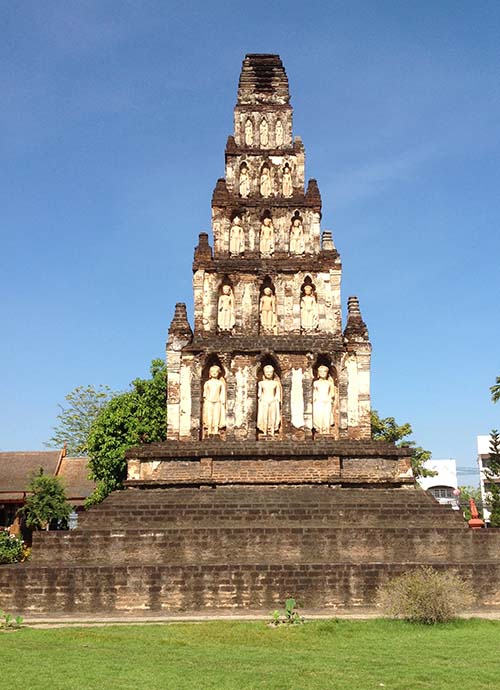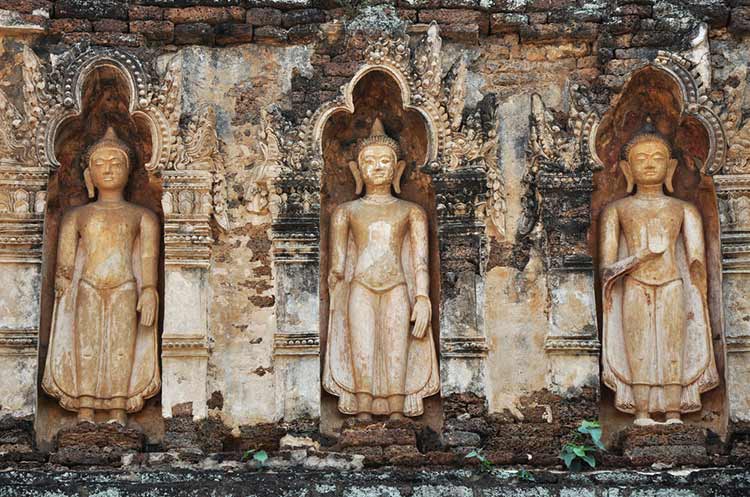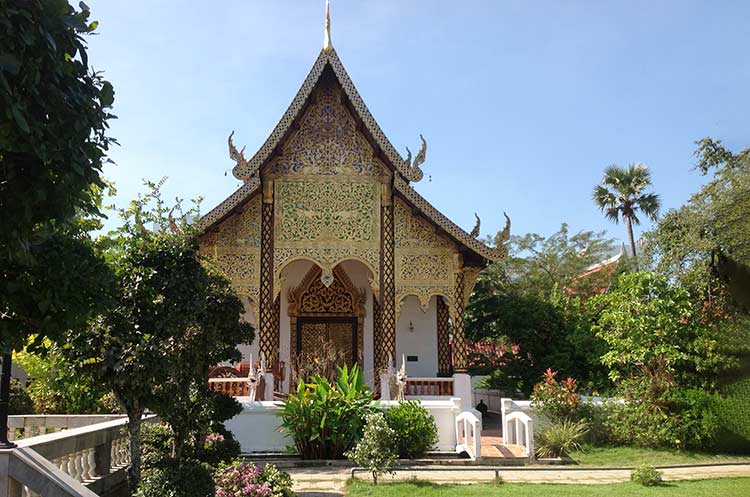
Wat Ku Kut
One of the last surviving examples of Mon Dvaravati architecture
Lamphun
The Wat Ku Kut is a little visited temple in the town of Lamphun comprising of a viharn, an ubosot, a sala and two ancient chedis.
Haripunchai Kingdom
The temple was founded around 1150 when Lamphun was the capital of the Mon Dvaravati Kingdom of Hariphunchai. According to local legend, the temple was founded much earlier in the days of Queen Chama Thewi, who founded the town of Lamphun in the early 9th century. The Wat Ku Kut is also known as Wat Chama Thewi or Wat Chama Devi named after the Queen.
Local legend tells that the spot where the temple was to be erected was determined by firing an arrow. The spot where the arrow landed marked the location. The most noticeable structures of the Wat Ku Kut are its two ancient chedis.
Mahabol chedi
The Wat Ku Kut houses one of the last surviving examples of Mon Dvaravati architecture in Thailand, the Mahabol chedi. The well preserved stepped pyramid chedi is also known as the Suwan Chang Kot chedi.
The chedi was built by King Athitayarat of the Hariphunchai Kingdom to commemorate his victory over the Khmer halfway the 12th century. The current structure is from 1218, when it was rebuilt by King Saphsit after an earthquake damaged the original.
The brick chedi measuring 21 meters high is plastered with stucco. Standing on a square base are five square tiers of diminishing size. Each side of each tier contains three niches enshrining a standing image of the Buddha, decreasing in size towards the top. The images. cast in 1218 in molds, are in the Abhaya mudra (dispelling fear), the right hand raised. The arches over the niches contain intricate stuccoed decorations.

Similar chedis can be found at the Wat Phaya Wat in Nan, the Wat Mahathat in Sukhothai Historical Park, the Wat Phra That Hariphunchai in Lamphun, and the Wat Chedi Liam in Chiang Mai.
Ratana chedi
Next to the viharn stands another smaller stupa named Ratana chedi, which translates to “gem chedi”. The early 13th century octagonal chedi measuring 11½ meters high is made of brick and covered with stucco.
Above its high base is a niche on each of the chedi’s eight sides in which a standing image of the Buddha is enshrined. The Ratana chedi is topped with a relic chamber. Small niches just under the chamber contain seated images of the Buddha. The top portion of the chedi has collapsed.
Viharn
The more recent viharn or assembly hall is a large building in central Thai style with a Lanna style gable. The balustrades of the stairway towards the viharn carry a Naga snake sprewing out a Makara, a sea animal from Hindu mythology. The wooden window panels are adorned with depictions of celestial beings in gold colors on a red background.
Principal Buddha image
Seated on an elaborate pedestal is the temple’s principal Buddha image, a large image in the “Calling the Earth to witness” posture.
Murals depicting historic scenes
Murals on the upper part of the walls depict scenes from the history of Hariphunchai and Queen Chama Thewi, including scenes of battles.
Mural depicting a local legend about Queen Chama Thewi
On the back wall to the left of the principal Buddha image is a mural depicting a legend about Queen Chama Thewi. It shows Viranga, King of the Lawa people on top of Doi Suthep mountain throwing a spear towards the town of Hariphunchai (present day Lamphun).
According to the legend Viranga had wanted for many years to marry Queen Chama Thewi. Finally the Queen agreed provided that Viranga could throw three spears from the top of the mountain into the walled town. After the first spear had reached the town, Queen Chama Thewi who feared Viranga would succeed, offered him a turban made out of her sarong. Some menstrual blood that was still in the cloth weakened Viranga, after which he failed his second attempt.

Ubosot
The ubosot is a central Thai style building with a Lanna style gable with wood carvings of golden flower motifs. On top of its two tiered roof are chofah, an ornamental element shaped like a thin bird that represents Garuda. Near the ubosot’s entrance door stands an ancient stone stele, inscribed with Mon script.
A third chedi on the grounds is much more recent. Each side of the square structure contains a niche enshrining a golden Buddha image.
How to get to the Wat Ku Kut
The temple is found on Chamadevi road (road 1015) a little over one kilometer West of Lamphun town center, next to Lamphun Hospital.
To get there, hire a samlor (trishaw) from the town center for about 40 Baht one way. For the way back into town, get a samlor at the hospital.
Opening hours
The Wat Ku Kut opens daily during daylight hours.
Entrance fee
Admission is free.